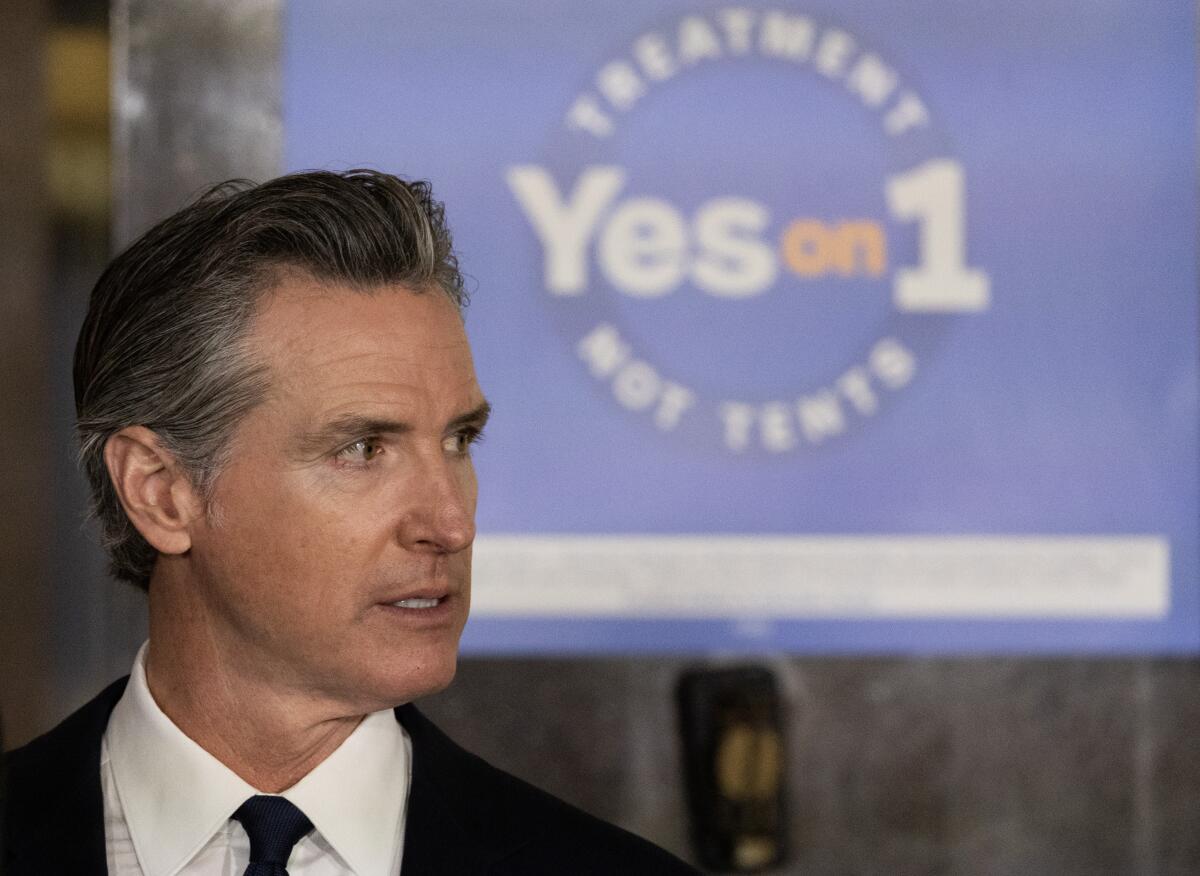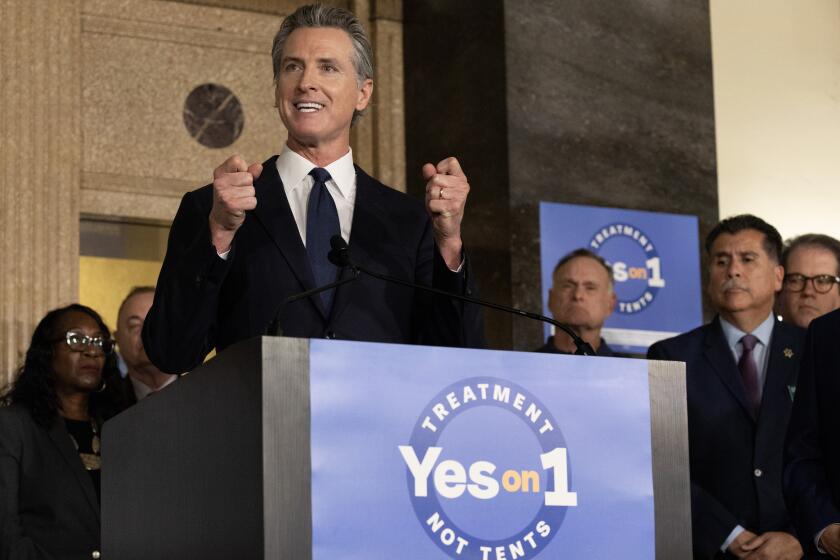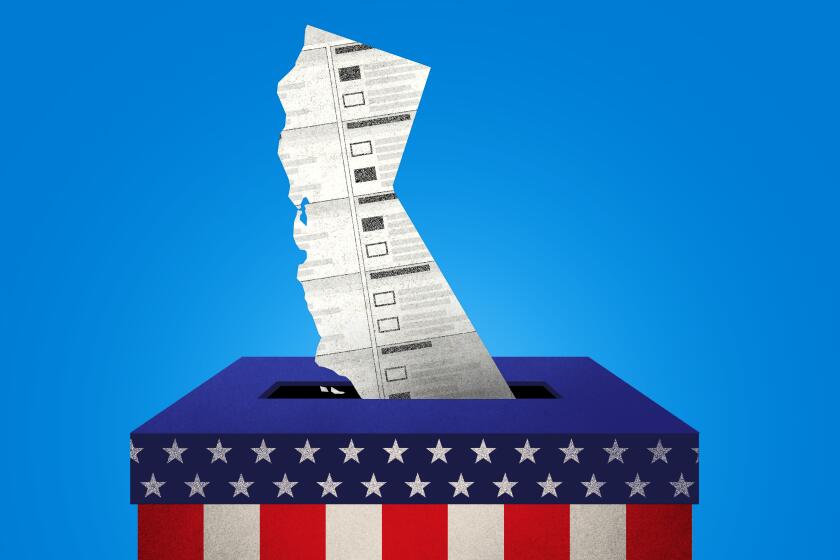The cost of Prop. 1: Newsom’s plan to transform California’s mental health system

- Share via
If approved by voters on Tuesday, Gov. Gavin Newsom’s ballot measure to overhaul the state’s mental health services system and sell bonds to finance more than 10,000 treatment beds across California could cost the state up to $14 billion.
Opponents of Proposition 1 argue the price is too high.
“What California needs to do is take a step back and figure out how can we spend this money effectively,” said Karen Vicari, director of public policy for the nonprofit advocacy Mental Health America of California. “We’re just wasting money. We’re just throwing money at a problem with no understanding of the root causes and how to truly solve homelessness.”
The measure, which is on the March 5 statewide primary ballot, asks for voter approval to sell $6.4 billion in government bonds to support more treatment facilities. Bonds, which are bought by investors, act as loans that the state pays back with interest.
The California Department of Finance estimates that the Behavioral Health Infrastructure Bond within Proposition 1 will cost a total of $14 billion.
Anthony York, a spokesperson for the Yes on 1 campaign, pointed out the measure won’t increase taxes on Californians. Instead, Proposition 1 provides accountability for how existing tax dollars are spent, he said.
“Prop. 1 will provide care for thousands of people struggling with mental health issues who are currently living on our streets and sidewalks, without raising taxes,” York said in a statement. “This is precisely the kind of smart investment the state should prioritize — getting people out of encampments and into treatment.”
California’s homelessness and mental health crisis is so dire that Republicans and Democrats are leaving their ideological corners and stepping into an unfamiliar middle ground to try to solve the problem.
How much will Proposition 1 cost?
That depends on whom you ask.
The official voter guide compiled by the California secretary of state quotes an estimate of $310 million annually over a 30-year period from an analysis by the Legislative Analyst’s Office. The LAO analysis did not include a total cost estimate over the life of the bond, which will be determined in part based on when the bonds are sold and interest rates at that time.
The state finance department offered its own estimate. On average over the life of a bond the state pays $2 for every $1 borrowed, said H.D. Palmer, a spokesperson for the department.
“For the Behavioral Health Bond, if approved, we estimate it would result in $14 billion in total debt service over the life of the bond, with an average annual debt service cost of $238 million per year,” Palmer said in an email.
The difference between the estimates can be chalked up to varying interest rates, maturity periods, and timelines for issuing the bonds.
Gov. Gavin Newsom crafted the measure to reform California’s mental health system, including a $6.4-billion bond for new facilities.
Who will pay for it?
Regardless of where the final cost lands, the money will be paid from the state general fund, the account used to pay for most public services.
Ross Brown, principal fiscal and policy analyst with the LAO, said the state pays about $5 billion annually in debt service, which includes payment for general obligation bonds and lease revenue bonds, from the general fund. Debt service payments are less than 3% of the state’s overall general fund budget, he said.
“It’s actually the lowest it’s been in the last couple of decades,” Brown said.
The downside of using bonds, Brown said, is that the state can’t scale back the bonds after they’ve been sold and must commit to making payments over a long period even when state revenues drop. On the upside, selling bonds allows the state to make important investments without having all of the cash available upfront.
Cash is in shorter supply this year as budget deficit estimates range from Newsom’s projection of a $37.9-billion shortfall to LAO predictions of a $73-billion fiscal hole in 2024. Finding hundreds of millions of dollars to pay for the bond, without raising taxes, will require the state to trim other programs from the general fund.
With California in the middle of a budget crunch, lawmakers and interest groups also want to place other bond measures on the November ballot to fund a variety of programs, such as combating climate change and increasing housing.
California’s primary election takes place on March 5. Read up on the races in L.A. city, L.A. County and other areas.
How will the money be used?
A “yes” vote on Proposition 1 would approve the $6.4-billion bond to build facilities to provide 10,000 treatment beds.
An LAO analysis of the measure says $4.4 billion from the bond sales would go to a state program that builds more places for mental health and drug or alcohol treatment, and within that bucket, a total of $1.5 billion is required for local government and Native American tribes. An additional $2 billion would fund a state program that turns motels, hotels and other vacant buildings into housing for the homeless, with half of that funding dedicated to veterans.
Proposition 1 would also revamp the Mental Health Services Act approved by voters in 2004. The act imposes a 1% tax on incomes in excess of $1 million to fund the expansion of mental health treatment options in California. The act funds 30% of the state’s mental health system.
If approved, Proposition 1 would change the state’s mental health system to better serve Californians with substance use disorders regardless of whether they are suffering from a mental health condition. Proposition 1 doesn’t change the tax, but seeks to reconfigure how the money from the act can be spent.
The state would receive a larger share of the tax money from the act, from up to 5% under current law to up to 10%, which means a smaller share of 90% would go to counties. Counties would also be required to spend more money from the act on housing and personalized support services, which the LAO describes as employment assistance and education. Less money from the act would be available for other services, including treatment and outreach.
The measure also would increase state oversight of county spending on behavioral health.
Vicari said she’s concerned that the changes would mean less help available to Californians in the early stages of need if more funding is diverted to higher levels of care.
“It’s a lot of community-based organizations that provide really effective services that don’t have the ability to bill Medi-Cal, and they’re going to be the first ones who lose their funding from the counties,” Vicari said.
At a Proposition 1 campaign event in San Diego on Thursday, Newsom described the measure as an opportunity to fix mistakes of the past.
Under the leadership of then-Gov. Ronald Reagan, California in the 1960s began shuttering state psychiatric hospitals without adding adequate housing and mental health services at the local level. Newsom repeatedly points to that policy decision as a cause of the state’s mental health and homelessness crisis.
“On March 5, we have the opportunity to fulfill that original vision and right that wrong and get something done that’s big and bold and scaled,” Newsom said. “That’s the opportunity.”
More to Read
Sign up for Essential California
The most important California stories and recommendations in your inbox every morning.
You may occasionally receive promotional content from the Los Angeles Times.














